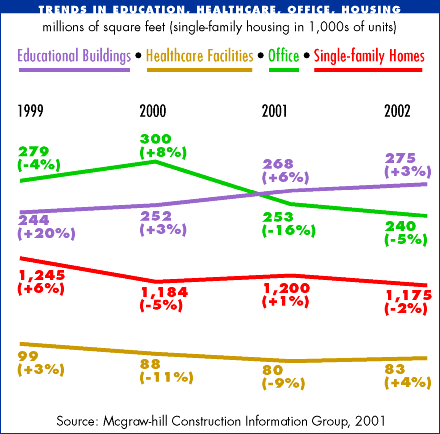
Highlights of the FW Dodge Outlook 2002 Executive Conference

Director, Economics and Market Research
"Although we have been tightening ship all year, we are going into 2002 scared, and our budgets may not be worth the paper they are written on," remarked one principal of a large architecture firm at a mid-October construction markets conference.
Yes, uncertainty looms large over all predictions for next year's business conditions. The situation is particularly poignant given that many firms have seen significant growth in revenues and staff in 2000, and even the earlier part of this year, and now these very same firms worry that they may need to shift gears fast.
The filled-to-capacity audience was attentive and focused at the annual F.W. Dodge Outlook 2002 Executive Conference, sponsored by the McGraw-Hill Construction Information Group and held October 30 this year in Washington, D.C. They patiently absorbed detailed presentations of tables and charts by a daylong procession of noted economists. David Wyss, chief economist at Standard & Poor's, remarked that his task was much easier in previous years when the economy was robust. "We are in a recession, the question is how long and how deep," he said. The recession may be mild, he noted hopefully—one, because the federal government is "shoving interest rates down" and also because the rebuilding activity and security spending may help offset some of the decline.
Where are we in the
cycle?
This year will be the 10th straight year of expansion of total construction
activity, and "all good things must come to an end," explained
Robert Murray, vice president of economic affairs, McGraw-Hill Construction
Information Group. In his detailed outlook for 2002, Murray said that
the expansion of the '90s was different from the cyclical nature of the
'70s and '80s. The current cycle (measured in constant 1996 dollars) reached
its peak in 1999 and dropped 2% each year in 2000 and 2001. It is expected
to drop 3% in 2002, bringing it to the same levels as 1997 and 1998. "Some
signs of deceleration are very much here, but we have not fallen drastically
as yet," he summarized.
Housing, institutional,
public works up in 2001
In 2001, single family housing stands out with a 3% increase, as does
institutional building, with school construction as the mainstay. Public
works show a 7% increase in 2001 and will benefit from increased public
funding in response to the September 11 attacks. On the other hand, income
properties (stores, shopping centers, offices, hotels, and multifamily
housing) make up the sector most vulnerable to a weak economy, recording
a 7% drop in 2001.

2002 outlook highlights
![]() •
Rising student enrollment will help the new school construction sector
with a 3% growth in 2002, down from a 6% growth in 2001 (and a possible
decline in 2003)
•
Rising student enrollment will help the new school construction sector
with a 3% growth in 2002, down from a 6% growth in 2001 (and a possible
decline in 2003)
• Rebound in health-care facilities is expected in 2002, after two
years of decline
• After very strong activity in 2000, office-building construction
is dropping back in 2001 and 2002
• Single-family housing will dip in the fourth quarter of 2001 and
early in 2002; even with renewed growth in the latter half of 2002, the
overall forecast is a drop of 2% over this year
• Multifamily housing has resisted the up/down cycle, and a 2% increase
is forecasted for 2002.
Do you have the right
map?
In a staccato presentation filled with colorful anecdotes, Seth Godin,
author of Permission Marketing, and the opening presenter at this conference,
remarked that "having the right maps when you are in a business that
has a long lead time is important." Citing mantras such as "change
is the new normal," he highlighted the need to train employees to
expect change. He also explained the value of fast-feedback loops, using
the example of the CEO of Kinko's who tirelessly visited each store to
see what worked and what did not—and immediately shared his findings
with all Kinko's stores. Negative feedback—titled "hotwash"
by Godin—proved to be similarly valuable to the success and survival
of any business.
So, if you are in the process of crafting a strategy for your firm's primary markets in 2002, a good starting point is a detailed sector-by-sector forecast for all the different segments of the construction industry.
Copyright 2001 The American Institute of Architects. All rights reserved.
![]()
| Construction
Outlook 2002, by Robert A. Murray, vice president, economic affairs,
McGraw-Hill Construction Information Group, Two Penn Plaza, New York,
NY 10121 www.construction.com, $495. |
|